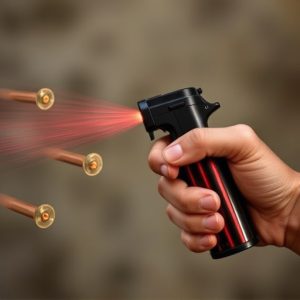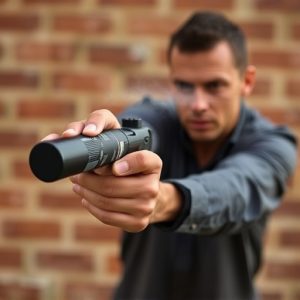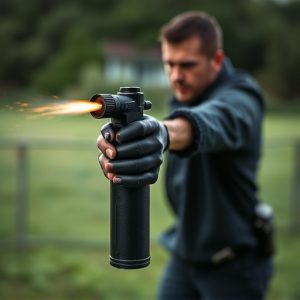Immediate Care for Pepper Spray: Equipment, Uses, and Legalities for Law Enforcement
Pepper spray, a non-lethal weapon, temporarily disables through eye and respiratory irritation. Prop…….
Pepper spray, a non-lethal weapon, temporarily disables through eye and respiratory irritation. Proper immediate care, including fresh air, water flushing, and slow breathing, alleviates symptoms. Law enforcement officers require thorough training in its responsible use and de-escalation techniques. A well-equipped pepper spray kit with high-potency aerosol, protective gear, and first aid supplies is essential for immediate care and safety during deployments, adhering to legal guidelines and preventing secondary injuries.
“Law enforcement officers require specialized equipment to maintain order and ensure public safety, and pepper spray is a critical component. This article explores the multifaceted aspects of law enforcement pepper spray equipment. From understanding its uses and impact to deciphering legal considerations, we guide you through essential components, application techniques, and immediate care guidelines. Discover how proper training and well-equipped kits can enhance officer effectiveness while ensuring safe and responsible use of pepper spray.”
- Understanding Pepper Spray: Its Uses and Impact
- Essential Components of a Well-Equipped Pepper Spray Kit
- Application Techniques and Immediate Care Guidelines
- Legal Considerations and Training Requirements for Law Enforcement Use
Understanding Pepper Spray: Its Uses and Impact
Pepper spray, a powerful non-lethal weapon, has become an integral part of law enforcement equipment worldwide. It is designed to incapacitate individuals temporarily through targeted irritation of the eyes and respiratory system. When deployed, pepper spray creates a burning sensation, leading to temporary blindness and difficulty breathing, thereby enabling officers to control and subdue suspects safely.
The immediate care for pepper spray exposure is crucial. Those affected should immediately seek fresh air by moving to an open area. In cases of eye irritation, flushing with clean water for at least 15 minutes can help alleviate symptoms. If breathing becomes challenging, individuals should try to stay calm, breathe slowly, and seek medical attention if symptoms persist or worsen. Proper training in the use of pepper spray and its de-escalation techniques is essential for law enforcement officers to ensure they employ this tool responsibly and effectively.
Essential Components of a Well-Equipped Pepper Spray Kit
A well-equipped pepper spray kit should include several essential components to ensure effective and safe immediate care during law enforcement operations. Firstly, a high-quality pepper spray aerosol is paramount, with various options available based on desired strength and range. Additionally, protective gear such as gloves, eye protection, and respirators are crucial for safeguarding officers from potential cross-contamination.
The kit must also contain essential tools for proper application and immediate care. This includes absorbent materials like tissues or towels to help manage residual spray, along with a decontaminant solution for thorough cleaning after use. Moreover, having on hand a first aid kit tailored for pepper spray exposure is vital, equipped with items like eye wash, burn cream, and antihistamines to provide prompt care for affected individuals.
Application Techniques and Immediate Care Guidelines
Application Techniques and Immediate Care Guidelines
The effective application of pepper spray is a critical skill for law enforcement officers, requiring proper technique to ensure its successful deployment. Officers should be trained in various application techniques, such as the thumb-in-canister method, where the trigger finger protects the nozzle while aiming at close range, and the overhand grip for longer-range shots. Proper distance and angle are crucial; officers should practice aiming at the face or eyes, as pepper spray is most effective when targeted at these areas.
Immediate care after exposure to pepper spray is essential to mitigate its effects. Victims may experience respiratory distress, nausea, and extreme discomfort. First responders should provide clear, open airways, administer oxygen if needed, and monitor vital signs. Eye irrigation with clean water for at least 15 minutes is critical to reduce eye irritation and potential long-term damage. Ensuring the immediate care of individuals affected by pepper spray is not only a matter of professional responsibility but also contributes to public safety and the overall effectiveness of law enforcement operations.
Legal Considerations and Training Requirements for Law Enforcement Use
The legal landscape surrounding law enforcement’s use of pepper spray is intricate and varies across jurisdictions, emphasizing the need for agencies to stay updated on regional regulations. Officers deploying pepper spray must act within the boundaries set by laws protecting both public safety and individual rights. Proper training is paramount; it ensures that officers understand when and how to deploy this equipment effectively while minimizing risks. This includes learning about the immediate care required after spraying, such as decontamination procedures, to prevent secondary injuries.
Agencies are responsible for equipping their officers with the necessary knowledge and resources to make informed decisions during encounters. Regular training sessions should cover different scenarios, including de-escalation techniques, crowd control management, and the appropriate use of force, ensuring that pepper spray is a last resort and used proportionately. Adhering to legal guidelines and providing adequate training promotes a balanced approach to law enforcement, fostering public trust while maintaining officer safety.
Pepper spray is a powerful tool in law enforcement, offering both deterrence and incapacitation. However, its proper use requires rigorous training and adherence to legal guidelines. By understanding the essential components of a well-equipped kit, effective application techniques, and critical immediate care for pepper spray exposure, officers can maximize its effectiveness while minimizing risks. Ensuring these practices are standardized and enforced fosters public safety and protects both officers and citizens alike.


